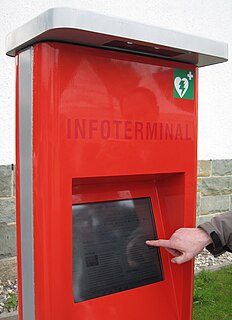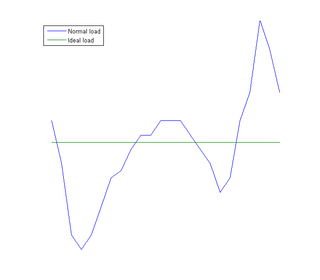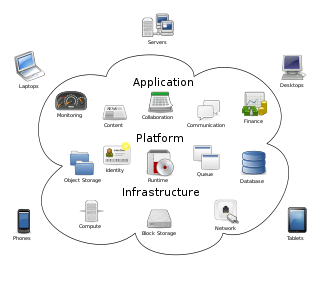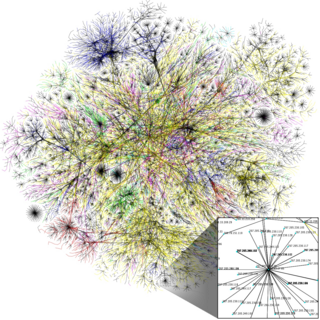LonWorks is a networking platform specifically created to address the needs of control applications. The platform is built on a protocol created by Echelon Corporation for networking devices over media such as twisted pair, powerlines, fiber optics, and RF. It is used for the automation of various functions within buildings such as lighting and HVAC; see building automation.

Telematics is an interdisciplinary field that encompasses telecommunications, vehicular technologies, for instance, road transportation, road safety, electrical engineering, and computer science. Telematics can involve any of the following:

Shenyang Ligong University is a university in Shenyang, Liaoning, China under the provincial government. Its campus is in a new district of Hunnan New District.

A KVM switch is a hardware device that allows a user to control multiple computers from one or more sets of keyboards, video monitors, and mice. Although multiple computers are connected to the KVM, typically a smaller number of computers can be controlled at any given time. Modern devices have also added the ability to share other peripherals like USB devices and audio.

An interactive kiosk is a computer terminal featuring specialized hardware and software that provides access to information and applications for communication, commerce, entertainment, or education.
A currency detector or currency validator is a device that determines whether notes or coins are genuine or counterfeit. These devices are used in many automated machines found in retail kiosks, self checkout machines, arcade gaming machines, payphones, launderette washing machines, car park ticket machines, automatic fare collection machines, public transport ticket machines, and vending machines.
Kiosk software is the system and user interface software designed for an interactive kiosk or Internet kiosk enclosing the system in a way that prevents user interaction and activities on the device outside the scope of execution of the software. This way, the system replaces the look and feel of the system it runs over, allowing for customization and limited offering of ad-hoc services. Kiosk software locks down the application in order to protect the kiosk from users which is specially relevant under, but not only limited to, scenarios where the device is publicly accessed such libraries, vending machines or public transport. Kiosk software may offer remote monitoring to manage multiple kiosks from another location. Email or text alerts may be automatically sent from the kiosk for daily activity reports or generated in response to problems detected by the software. Other features allow for remote updates of the kiosk's content and the ability to upload data such as kiosk usage statistics. Kiosk software is used to manage a touchscreen, allowing users to touch the monitor screen to make selections. A virtual keyboard eliminates the need for a computer keyboard.

Sybase iAnywhere, is a subsidiary of Sybase specializing in mobile computing, management and security and enterprise database software. SQL Anywhere, formerly known as SQL Anywhere Studio or Adaptive Server Anywhere (ASA), is the company's flagship relational database management system (RDBMS). SQL Anywhere powers popular applications such as Intuit, Inc.'s QuickBooks, and the devices of 140,000 census workers during the 2010 United States Census. The product's customers include Brinks, Kodak, Pepsi Bottling Group (PBG), MICROS Systems, Inc. and the United States Navy. In August 2008.

In systems management, out-of-band management involves the use of management interfaces for managing servers and networking equipment.
Mobile device management (MDM) is an industry term for the administration of mobile devices, such as smartphones, tablet computers and laptops. MDM is usually implemented with the use of a third party product that has management features for particular vendors of mobile devices.

Load management, also known as demand side management (DSM), is the process of balancing the supply of electricity on the network with the electrical load by adjusting or controlling the load rather than the power station output. This can be achieved by direct intervention of the utility in real time, by the use of frequency sensitive relays triggering the circuit breakers, by time clocks, or by using special tariffs to influence consumer behavior. Load management allows utilities to reduce demand for electricity during peak usage times, which can, in turn, reduce costs by eliminating the need for peaking power plants. In addition, some peaking power plants can take more than an hour to bring on-line which makes load management even more critical should a plant go off-line unexpectedly for example. Load management can also help reduce harmful emissions, since peaking plants or backup generators are often dirtier and less efficient than base load power plants. New load-management technologies are constantly under development — both by private industry and public entities.
Remote service software is used by equipment manufacturers to remotely monitor, access and repair products in use at customer sites. It’s a secure, auditable gateway for service teams to troubleshoot problems, perform proactive maintenance, assist with user operations and monitor performance. This technology is typically implemented in mission-critical environments like hospitals or IT data centers – where equipment downtime is intolerable.

Cloud computing is the on demand availability of computer system resources, especially data storage and computing power, without direct active management by the user. The term is generally used to describe data centers available to many users over the Internet. Large clouds, predominant today, often have functions distributed over multiple locations from central servers. If the connection to the user is relatively close, it may be designated an edge server.
Gemalto M2M is the machine to machine (M2M) division of Gemalto,, a digital security company. Gemalto M2M's Cinterion products and services allow machines, equipment, vehicles and devices to communicate over cellular networks providing Edge-to-Enterprise (E2E) connectivity that enables the Internet of things (IoT). Unlike consumer-grade cellular technology, M2M technology is designed for longevity to withstand extreme conditions of temperature, moisture and vibration often encountered by enterprise and industrial wireless applications. Cinterion products and services are engineered to provide reliable communications for more than 10 years in the field.
Alert Standard Format (ASF) is a DMTF standard for remote monitoring, management and control of computer systems in both OS-present and OS-absent environments. These technologies are primarily focused on minimizing on-site I/T maintenance, maximizing system availability and performance to the local user.
Mobile enterprise asset management refers to the mobile extension of work processes for maintenance, operations and repair of corporate or public-entity physical assets, equipment, buildings and grounds. It involves management of work orders via communication between a mobilized workforce and computer systems to maintain an organization's facilities, structures and other assets.

Odyssey Software provides mobile device management and software development tools to enterprise companies either directly or through partner solutions. Its technology allows companies to manage multiple mobile operating systems at a detailed level, including functions such as inventory collection, software management, remote control, and device configuration.

Ventus is a US based company founded in 1999 and headquartered in Norwalk, Connecticut that provides secure private line wireless services, and manufactures cellular wireless hardware.











